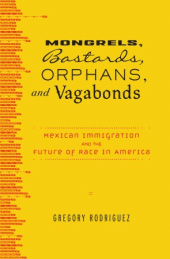 |
 |
 |
 Entertainment | Books | November 2007 Entertainment | Books | November 2007  
American Xenophobes Need Mexican Immigration Facts, Not Fences
 Bill Murray - Bloomberg Bill Murray - Bloomberg
go to original


| Wide-ranging and provocative, Mongrels, Bastards, Orphans, and Vagabonds offers an unprecedented account of the long-term cultural and political influences that Mexican Americans will have on the collective character of our nation.

Check it out at Random House |
The U.S., the world's premier immigrant nation, has slipped into one of its periodic bouts of xenophobia, complete with single-issue presidential candidates and congressional funding for a high-tech fence along its 2,000-mile (3,200-kilometer) border with Mexico.

This debate is as pointless as it is emotive, Los Angeles Times columnist Gregory Rodriguez argues in "Mongrels, Bastards, Orphans and Vagabonds," a book that traces more than 300 years of Hispanic influence on North American culture and politics.

Drawing on reams of facts, figures and forgotten history, Rodriguez, a Mexican American who grew up in Los Angeles, plants an idea that becomes difficult to dislodge: Because "Hispanicity continues to absorb rather than exclude the cultures it encounters," he writes, Hispanic immigration is forcing the U.S. to reinterpret the purpose of the "melting pot" to include racial as well as ethnic mixing.

Integration and assimilation are fast becoming the rule, not the exception, in Hispanic immigration, Rodriguez shows. By the 1990s, 32 percent of second-generation and 57 percent of third- generation Latinos had married outside their ethnic group. In 1990, 64 percent of third-generation Mexican-American children spoke only English at home; by 2000, the figure was 71 percent.

In 1997, Mexican President Ernesto Zedillo signed a law allowing migrants who became naturalized U.S. citizens to retain their Mexican nationality. Five years later, only 1.6 percent of those eligible had taken the opportunity.

Nation Survives

It's true that at least 6 million Mexicans, or about 5 percent of the country's population, today reside in the U.S. illegally. This sounds like a lot, until you realize that double that proportion - 10 percent of all Mexicans - lived illegally on U.S. soil between 1900 and 1930. Somehow, America survived.

Rodriguez does slip up in places. He underplays how female sexual emancipation in the 1960s contributed to intermarriage. He also fails to acknowledge - by either massive oversight or design - the huge difference between African-American integration (or lack thereof) and that of other non-European immigrant groups.

But he's spot on when he mocks the muddled thinking of militant-left Chicano activists who argued in the 1960s that racism lay at the heart of the American dream.

"Multiculturalism, which essentially rejects assimilation, is a critique of American society sustained by two contradictory beliefs," he writes. "First, the U.S. is a racist society that won't permit Chicanos to assimilate; second, assimilation into the mainstream is an inexorable and insidious process that must be resisted at all costs."

'Americanized' Mexico

Assimilation has not only become a fact; it is actually moving south of the border. Much of Mexico is fast becoming "Americanized," Rodriguez says, thanks to the increased trade and media links between the two nations that followed the North American Free Trade Agreement.

In the past 15 years, household incomes and female literacy in Mexico have risen so fast that the country's birthrate has dropped to 2.1 children per female - the same level as in the U.S. - from 3.3 children per female, the World Bank reports.

Given this math, there's a chance too few Mexicans will sneak over the border 20 years from now to support the U.S. economy. Will anyone be left to frame a two-story house? Who will get the vegetables to America's supermarket shelves?

Current xenophobe-for-president Thomas Tancredo, a U.S. congressman from Colorado, would probably call a shortage of farm workers a sinister government conspiracy. Rodriguez may say it's the obvious consequence of a burgeoning Hispanic middle class - and just a new chapter in a very old American story.

"Mongrels, Bastards, Orphans and Vagabonds: Mexican Immigration and the Future of Race in America" is published by Pantheon (336 pages, $26.95).

(Bill Murray writes for Bloomberg News. The opinions expressed are his own.)

To contact the writer of this review: Bill Murray in London at atwmurray1@bloomberg.net. | 
 | |
 |



